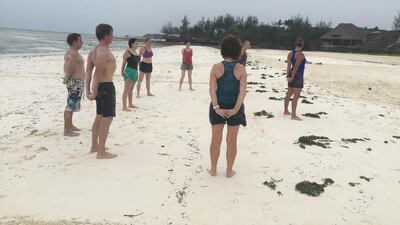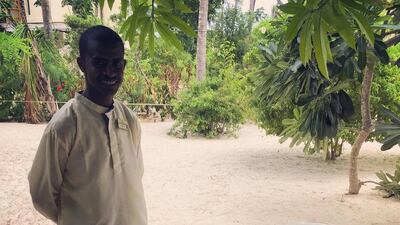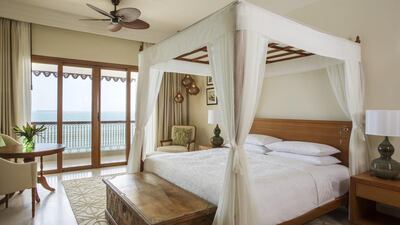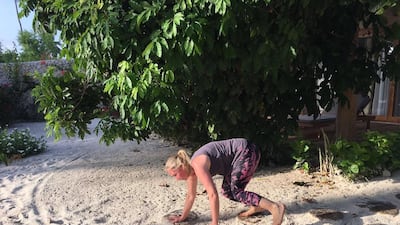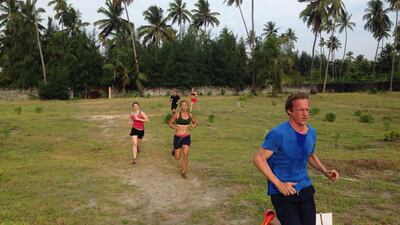Sunset in Stone Town, and on the ancient city’s public beach the crowds are massing. Muscular young men run up and down the shoreline in football strips while others practise yoga. Children jump in and out of the water or play football, while teenage boys line up to perform long chains of backflips, and spectators film them on smartphones. One, two, three – sometimes eight backflips are linked, and a dynamic pose is struck upon landing. They have all the athleticism of professional gymnasts.
Zanzibar, it seems, is the ideal place for a fitness holiday. I’ve signed up with Wildfitness, a UK-based company dedicated to natural movement combined with paleo-style eating. My week-long retreat will take place in Paje, on the east coast, but irregular flights mean I’ve got a day to spare. I’m staying at the new Park Hyatt Zanzibar, a Dubai-owned hotel, one of Stone Town’s grand old restored and newly constructed seaside mansions. The best things about the hotel are that it has only 67 rooms and a lovely, breezy and long beach-facing terrace, from where you can watch the daily procession in comfort.
I’m staying in one of the hotel’s four grand suites in the original building. They feature lots of space – mine is 100 square metres – furniture from Indonesia and India, and Persian rugs, but all the modern standards such as Wi-Fi and air con. There’s a four-poster bed and what seems like dozens of windows, which open to the sound of the waves. Even when they’re closed at night, the sound is so relaxing it imprints itself onto your day.
The property has an Anantara spa in the most attractive old part of the hotel, with stone walls almost a metre thick and domed ceilings dating from the 1800s. There are only three treatment rooms, and Unesco protection means there’s no steam room or sauna, but it’s all to the good as my local therapist seems to have all the time in the world and soon gets to work with an almond oil “spice massage” with a mixture of lavender, ginger, plai, clove and black pepper.
I float around the old town with a guide – necessary if you don’t want to get lost or are short on time. Simai Haji is quietly well-informed, speaking only when necessary, allowing me to soak in whatever views or thoughts I desire. He takes me to a selection of buildings, including the Hamamni Persian Baths, no longer in use, but open to the public for a small fee. The largest of their kind in Zanzibar, they were designed by Iranian architect Haji Gulamhussein for Sultan Barghash (son of Said bin Sultan, the first Omani ruler of Zanzibar) and built between 1870 and 1888. The largest, a hexagonal room, is still atmospheric, as are the adjacent hot-and-cold baths.
At midday, I’m collected at the Park Hyatt by a driver from Zanzibar White Sand Luxury Villas & Spa, who takes me and another fitness-holiday volunteer, Emma, who is in her 30s and works for the UK Foreign & Commonwealth Office, on the 90-minute drive to Paje, a small collection of beach hotels on the island’s scenic and windy east coast.
The new resort is beautiful, with only 11 villas, made mostly out of wood in a blend of the luxurious and rustic. Ours has five bedrooms, plus a big living room, kitchen, large garden and small private pool outdoors. It feels like the Big Brother house, as other guests arrive and introduce themselves. This is the first time Wildfitness has operated in Zanzibar – it pulled out of Watamu, Kenya, due to security reasons – so there's an element of newness for all concerned.
We’re introduced to our trainers. There’s head coach Anne-Laure, a French-Italian woman who used to play basketball for France and whose tanned skin, sun-streaked hair and well-proportioned body seem to be the embodiment of Wildfitness principles. Then there’s Ivan, a stocky Kenyan fitness coach and safari guide based in Nairobi, who is the operations manager here, and Joshi, a swarthy Kenyan ex-athlete whom I met on a previous retreat five years ago.
Which brings me to why I’m here. Despite leaving that retreat in top form back in 2010, the intervening years have seen what athletes politely describe as “deconditioning”. Basically, thanks to a mostly sedentary lifestyle, my waistline had expanded and I had become very unfit. At the point where a few classes a week just won’t have enough of an impact is where these retreats come in. Three workouts a day, healthy food with no caffeine, fresh air and rest can work wonders – but it’s hard work. The compensation is that the accommodation is lovely. My room is huge, with expansive wood floors, a large shaded deck with sunbeds, a hammock and a view of the exotic trees, and an enormous bathroom. “Carrot and stick” is exactly what I need.
After a lunch of plain beefsteak, calamari and salad, it’s time for our assessments. I’m photographed in my bikini against a chart – as both shape and posture will be worked on – then we’re filmed – wearing the same clothes – jumping and throwing things. This will be repeated, and the results compared, at the end. Then there’s a “structural hygiene” session – and we’re shown how to use foam rollers, tennis balls and golf balls to alleviate the tension that our bodies will throw up over the week. As I roll back, my spine cracks in unexpected places. When I roll on my side, vertebrae seem to pop and crack. We also use wooden poles to increase joint mobility.
Then it’s down to the beach for our first session. The tide is out and the beach looks spectacular. There’s an indigo sky sliced in half by a white, sandy base encrusted with emerald. At low tide, the sea becomes a lagoon and is full of kitesurfers. The sand feels like flour. But there’s no time to stand around – working with partners, we mimic movements, race around each other in various formations and “wheelbarrow” each other through the sand. “Get used to the feel of your hands on the ground, taking your weight,” says Anne-Laure, as if it’s supposed to be enjoyable. All our sessions are done barefoot, which is harder than using trainers. Soon we’re gasping for breath, and it’s time to jump into the sea, followed by a shower and dinner.
At 6am the next morning, and every morning that week, my alarm goes off. There are no ifs, buts or self-scheduling – we’re all downstairs sipping ginger or lemongrass tea before an “animal circuit”, which involves, first, seated squats, then walking forwards and backwards in a low squat position, something like a duck. Although Anne-Laure does it easily, it’s agonising. I feel like my knees simply can’t take the strain and I can’t do more than a couple at once, though after a few strides, my legs feel alive. Then, on the beach – luckily before anyone else is awake to see us – we crawl around in positions such as crabs, bears and, finally, haul our bodies to the sea like fish. After a swim it’s time for breakfast – watered-down carrot and mango juice, ginger tea, yogurt with nuts, coconut pancakes and fruit. A waiter, who hasn’t been briefed about our restrictions, serves me coffee, but when I taste it, I feel strangely nauseous.
Our next session is barefoot running. The aim of this, says Anne-Laure, is to develop the “optimum tempo for efficiency”. By using the body’s own bounceback mechanisms of the Achilles to fire the legs up into the air, and minimising the length of time the feet spend on the ground, we can use our calf and thigh muscles less, meaning that we can go for longer. The body needs to be upright and lead with its chest, so there’s to be no leaning forward or back. We run on rough ground, concrete, stony walls and wood, which is fairly painful. We jump up and down stairs two at a time, and – worst of all – crawl down a set of stairs head first. With other group members in front and behind you, there’s not much scope for taking your time. Lunch is beef skewers, vegetables and salad, followed by a 90-minute break, in which I go straight to bed.
An afternoon boxing class in the dojo starts with a meditation session, then it’s bouncing up and down, rehearsing moves and sparring with a trainer, who barks sequences of different punches. In between we do burpees and jump from side to side with weights and onto and off steps. I find the boxing easier than the exercises. After a 90-minute session, we swim in the sea, shower, drink coconut water and have a workshop on “outdoor man”. Terms such as “survival response”, “kaizen” and “fixed or growth mindset” are thrown about before a dinner of grilled seafood and salads. Before bed, I realise that my legs, which usually feel dormant, are alive with circulation and energy. It’s a joy to collapse into bed, certain that you’ll sleep through.
When I wake up, it hurts to move. Dragging myself downstairs, it’s hard to imagine how we will be able to tackle “hanging and climbing”. The trainers deliberately don’t announce their programmes before, so your body almost gets fooled into doing things it hasn’t had time to question. Soon we’re climbing trees, swinging from them, walking and monkey-crawling along a slackline, jumping, doing pull-ups and bear-crawling along the ground. Before the end, my hands feel sore and painful. We finish with 50 Tabata-style push-ups and then jump in the pool before breakfast, which is exactly the same every day.
It feels like a day’s worth of exercise is done by 8am, but far from it. We review our running, which has been filmed. There’s something about seeing yourself and comparing yourself to others that is motivating. Though my technique is good, there is a woman in the group, who has had three children and who is in better shape than I am. “Your body just needs a bit of a shake-up,” says Anne-Laure, who has a nice way of putting things.
Before lunch there’s a “flow” session with Joshi, which I expect to be like yoga. However, although my body feels looser, after half an hour the moves start to be tiring, and I’ve got a slight pain in my right knee. We’re all sweating, but then it’s time for our swim assessment in open water, to check that we are strong enough for a later “challenge”. After yet another shower – we’re averaging three per day – it’s lunch. The food is less tasty than I’d hoped, but the good thing is that I’m eating less. After a rest, it’s my turn for a massage – one is included in the week-long package. The masseuse is great – hugging the touchline between pleasure and pain, she pulls, loosens and soothes.
Alas, the afternoon is not my own as there’s a “lifting” session. We lift logs, sandbags, planks and people, and it gets harder and harder, though the session is exciting and interactive, and in the end we’re covered in dirt. We play the “pole game”, in which we all stand in a circle and drop our poles and move to the left or right or spin around according to what Anne-Laure says. The rest of the group is eliminated, and I draw with Ivan.
There’s another workshop about life balance, food, mental and physical health, and relaxation, and Anne-Laure explains that we must push our bodies beyond their limits in order for the repair mechanism, human growth hormone (which also, apparently, makes you look younger), to be released each night. Then it’s dinner and bed. I’m happy that my shoulders feel loose, but my body feels overstimulated, and I sleep on and off. We’re woken at 4am by the sound of our air-con units bleeping after a power outage. I’m worried that the human growth hormone won’t have been able to do its job, and feel tired. After a 6.30am boxing session in which sweat pours from my body as it seems to explode with energy – the rest of the group seem taken aback by the power and aggression of my kicking – it’s breakfast and then back-to-back volleyball and water football. My energy level has tanked, and I feel quite low.
Appropriately, there’s a “wild eating” workshop in which Anne-Laure explains that man started eating grains 3,000 years ago, a blip in time compared to the thousands of years we spent eating meat, fruits and nuts. “The industrialisation of food is even more recent. We haven’t evolved to process an excess of carbs, which makes us fat. This is the excess calories and sugar being deposited in our cells, raising inflammation and making the brain and organs overactive.” There’s a lot of sense in this, and I buy into most of what she says. While this week we’re being stripped of dairy products and sugar in the form of bread, pasta, rice, potatoes and added sugar, this is being replaced with “densely nutritious food”. We’re told that “meat and animal fats, nuts and oils are very healthy”. I miss curries and other spicy foods, but Anne-Laure says “addictive” sugar-and-salt-laden sauces are difficult to monitor in hotels. I confess that despite not finding the carb-free food very enjoyable, I do feel better eating it, sleep better and find it easier to get up in the morning. We’re all less bloated and notice a trimming down in the midsection area. With prepared foods, “if there are more than two ingredients you don’t recognise, don’t eat it”, Anne-Laure suggests. I ask her about the culture of brunches in the UAE, expecting her to tell me to avoid them, but her response is surprising. “When we were hunter-gatherers, we would have eaten a ton of food at once, then fasted.” She suggested planning my dietary intake in the days before and after a big feast, in order to counter it. This could include fasting for a whole day after a multi-course meal, to “clean the body”.
That afternoon there’s a 7km barefoot run along the beach, two minutes at a time before a short walk and then running again. I feel practically asthmatic after a few minutes. Still, Ivan shows me how to keep jogging at a slow pace rather than stop altogether.
After a good sleep it’s our “passive morning”. Rather than sleep in, we decide to cycle 17km along the beach to The Rock, a seafood restaurant on a small rocky island. It’s tough on the legs thanks to the sand and wind, but enjoyable, and I have a delicious fish carpaccio with coconut cream and chilli, and lobster and tomato tagliatelle. But despite the anticipation, the pasta isn’t as amazing as I’d expected, and I realise I could and should have stopped at the ceviche. After we get a minibus back, there’s a “beach combo”, an assault course of jumping, crawling, carrying, diving rollovers and sprints. I notice a pain in my knee and calf, and slightly regret the long bike ride. When we finish, Joshi claims that we “still might have 5 or 10 per cent in the tank”, and so we run shuttles. I feel like I may have something in the tank, but all my tyres are busted.
The next morning is “lactic lift-off”. “Is this an iced cappuccino or milkshake?” I joke. Sadly not – it’s nine minutes of running over uneven ground, this time in trainers because the ground is rough. My legs, in agony after the bike ride, hurt and I can barely lift them. Geraldine, an Irish expatriate in her 50s who lives in Muscat and eschewed the bike ride, strides out strongly. We then practise “free-diving skills” – holding our breath underwater – before I take myself off to the spa again. Then it’s a nice lunch of tuna ceviche, spiced chicken, calamari skewers and salsa, before a session of throwing and lifting – this time mainly balls. In pairs – my partner is Geraldine – we run round a kind of circuit, skipping, doing press-ups and squats, animal crawling and throwing balls in five ways. We finish again with a swim in the sea, and I feel like I’ve turned a corner. My whole body feels strong, connected, relaxed and oxygenated.
Our evening workshop is a mixture of parkour videos and TED Talks, and a discussion about what we’ve learned and how we want to change our lives. People’s concerns range from changing their diets to managing their children’s, and staying active back at home. Anne-Laure’s advice is to enjoy food, move more, learn to relax, connect with whatever we are doing and spend time in nature.
Our last big activity involves a 2.4km swim from mangroves out into the open sea. We’ve not been told the distance, only that the “tide will be with us”. I begin strongly and swim on my own behind the two front runners. Despite thoughts about what’s down below, I calm my mind and push on, enjoying flocks of birds flying up ahead and glimpses of remote beaches. As I round a bend, suddenly it becomes choppy, with metre-high waves crashing over me. I backstroke into them and experience an explosion of adrenaline, which carries me out of the rough patch and into the home strait. Then we have dinner at Ali Pakachas, a beach restaurant. It’s a feast of delicious kingfish curry, spicy octopus, coconut rice, cabbage salad, vegetables, fries and calamari. It’s noticeably harder to get out of bed the next day, but our work is done. Our bodies have been purged of flab and are now burning more fuel.
There’s one last boxing session, which sees explosive power and conditioning exercises push fatigue away. Then we’re all given various awards for things we’ve achieved during the week – mine is for lifting. I have been surprised at how well the body reacts to so many workouts and how, having seemingly seized up, more exercise loosens it up. We’re all feeling something unstoppable within us that has always been there, but was waiting for something – be it permission or just opportunity – to unleash it. The human body, which so many of us choose to smother in weakness, fat or inactivity – is capable of incredible things. Its abilities are largely limited by our minds.
I’m dropped back into Stone Town that afternoon, at a beautiful old hotel called Emerson on Hurumzi, a combination of three buildings, the most impressive of which belonged to Tharia Topan, the son of a vegetable seller from Kutch, India, who, after being falsely accused of theft, jumped onto the first boat he saw. He worked his way up to become a successful businessman, accountant to the sultan and honorary prime minister. My room, called “Keep” and one of only 11, is on the top floor, with two rooftop “teahouses”. Though my legs are still smarting, it’s worth the effort to get up there. That night I enjoy a ceremonial “soro” moonlight dinner on the rooftop – stewed goat and fish, vegetables, a little rice. Breakfast is fresh mango and avocado juice, fresh fruit, a rice-flour pancake and tea or coffee. It’s like somebody’s told them. After a walk around town, I meet Emma at the nearby Emerson Spice hotel – equally spectacular – and we have a small, perfectly formed seafood curry for lunch. We head down to the beach and watch the sunset as boys do backflips off a wall. Give us another few weeks and we’ll be doing that, too.
Read this and other travel-related stories in Ultratravel magazine, out with The National on Wednesday, March 23.
rbehan@thenational.ae

